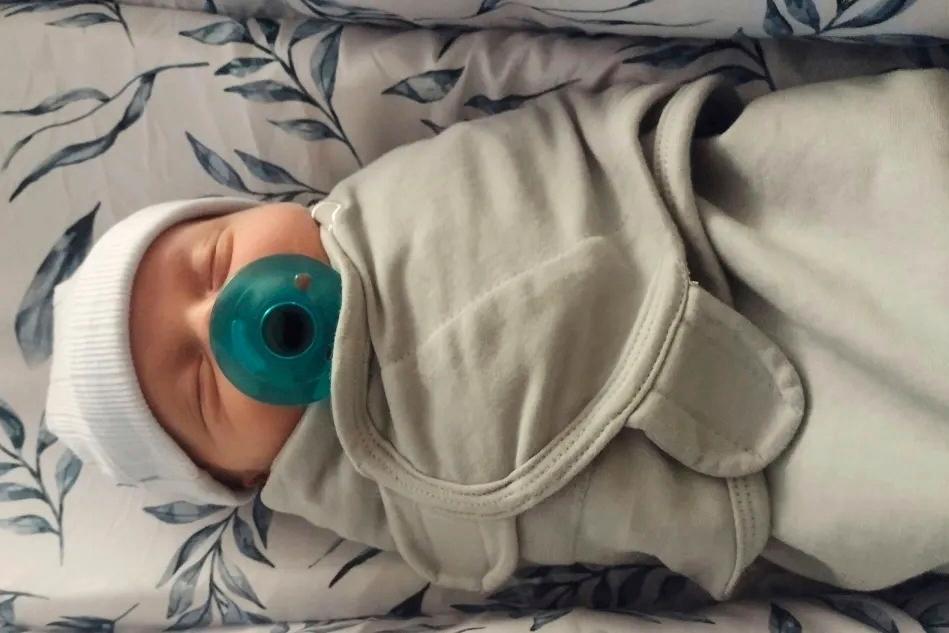
By KIMBERLEE KRUESI, Associated Press
A baby boy born to an Ohio couple developed from an embryo that had been frozen for more than 30 years — believed to be the longest storage time before a birth.
Tim and Lindsey Pierce in November 2024 at Rejoice Fertility in Knoxville, Tenn. (Rejoice and John David Gordon via AP)
In what’s known as embryo adoption, Lindsey and Tim Pierce used donated embryos that had been frozen since 1994 in pursuit of having a child. Their son Thaddeus was born July 26 from an embryo that had been in storage for 11,148 days, which the Pierces’ doctor says sets a record.
It’s a concept that has been around since the 1990s but is gaining traction as some fertility clinics and advocates, often Christian-centered, oppose discarding leftover embryos because of their belief that life begins at or around conception and that all embryos deserve to be treated like children who need a home.
“I felt all along that these three little hopes, these little embryos, deserved to live just like my daughter did,” said Linda Archerd, 62, who donated her embryos to the Pierces.
Just about 2% of births in the U.S. are the result of in vitro fertilization, and an even smaller fraction involve donated embryos. However, medical experts estimate about 1.5 million frozen embryos are currently being stored throughout the country, with many of those in limbo as parents wrestle with what to do with their leftover embryos created in IVF labs.
Further complicating the topic is a 2024 Alabama Supreme Court decision that said that frozen embryos have the legal status of children. State leaders have since devised a temporary solution shielding clinics from liability stemming from that ruling, though questions linger about remaining embryos.
Archerd says she turned to IVF in 1994. Back then, the ability to freeze, thaw and transfer embryos was making key progress and opening the door for hopeful parents to create more embryos and increase their chances of a successful transfer.
She wound up with four embryos and initially hoped to use them all. But after having one child, Archerd and her husband divorced, disrupting her timeline.
As the years turned into decades, Archerd said she was wracked with guilt about what to do with the embryos as storage fees continued to rise.
Eventually, she found Snowflakes, a division of Nightlight Christian Adoptions, which offers open adoptions to donors from people like Archerd. She was also able to set preferences for what families would adopt her embryos.
“I wanted to be a part of this baby’s life,” she said. “And I wanted to know the adopting parents.”
The process was tricky, requiring Archerd to contact her initial fertility doctor in Oregon and dig through paper records to get the proper documentation for the donation. The embryos then had to be shipped from Oregon to Rejoice Fertility in Knoxville, Tennessee. The clinic refuses to discard frozen embryos and has become known for handling embryos stored in outdated and older containers.
The Pierces live in London, in central Ohio, but had the embryo procedure done at Rejoice. Of the three donated embryos they received from Archerd, one wasn’t viable after thawing. Two were transferred to Lindsey Pierce’s womb, and one successfully implanted.
According to Dr. John David Gordon, it was the longest-frozen embryo to result in a live birth. Gordon says his clinic assisted in the previous record, when Lydia and Timothy Ridgeway were born in October 2022 from embryos frozen for 10,905 days, or almost 30 years. Their parents, who live in Oregon, already had four children, all conceived without a donor or IVF.
Related Articles
Cleanup of toxic East Bay waterway creates divisions
San Mateo County navigates immigrant fears as it attempts to improve water issues
Mihm: How Big Corn sabotaged Big Sugar to serve us high fructose
Fact check: Trump says he’s cut drug prices by up to 1,500%. That’s not possible
Is baby getting enough breastmilk? New device helps moms learn
“I think that these stories catch the imagination,” Gordon said. “But I think they also provide a little bit of a cautionary tale to say: Why are these embryos sitting in storage? You know, why do we have this problem?”
In a statement, Lindsey and Tim Pierce said the clinic’s support was just what they needed.
“We didn’t go into this thinking about records — we just wanted to have a baby,” said Lindsey Pierce, who is 34.
For Archerd, the donation process has been an emotional roller coaster: relief that her embryos finally found a home, sadness it couldn’t be with her and a little anxiety about what the future holds next, with possibly meeting the Pierces and the baby in person.
“I’m hoping that they’re going to send pictures,” she said, noting that the parents have already sent several after the birth. “I’d love to meet them some day. That would be a dream come true to meet — meet them and the baby.”